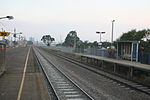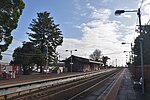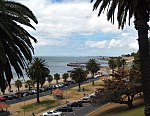Port of Geelong
Economy of GeelongPorts and harbours of Victoria (state)Transport in GeelongUse Australian English from January 2018

The Port of Geelong is located on the shores of Corio Bay at Geelong, Victoria, Australia. The port is the sixth-largest in Australia by tonnage.Major commodities handled by the port include crude oil and petroleum products, export grain and woodchips, alumina imports, and fertiliser. Major port industries include Graincorp's grain elevator and Viva Energy's Geelong Oil Refinery. The Port of Geelong handled $5.6 billion worth of bulk cargo in 2004–05, made up of 12 million tonnes of cargo from 543 ship visits.
Excerpt from the Wikipedia article Port of Geelong (License: CC BY-SA 3.0, Authors, Images).Port of Geelong
Geelong
Geographical coordinates (GPS) Address Website Nearby Places Show on map
Geographical coordinates (GPS)
| Latitude | Longitude |
|---|---|
| N -38.116666666667 ° | E 144.38333333333 ° |
Address
Geelong
3218 Geelong
Victoria, Australia
Open on Google Maps








